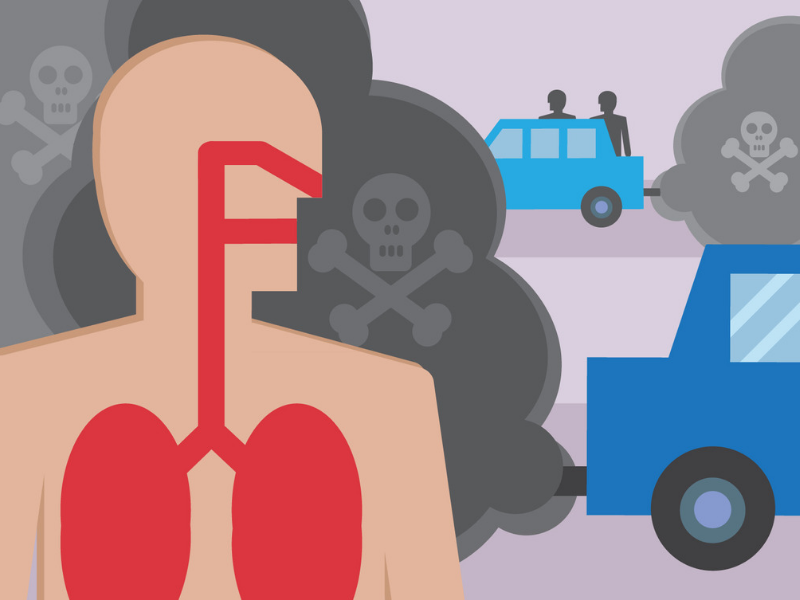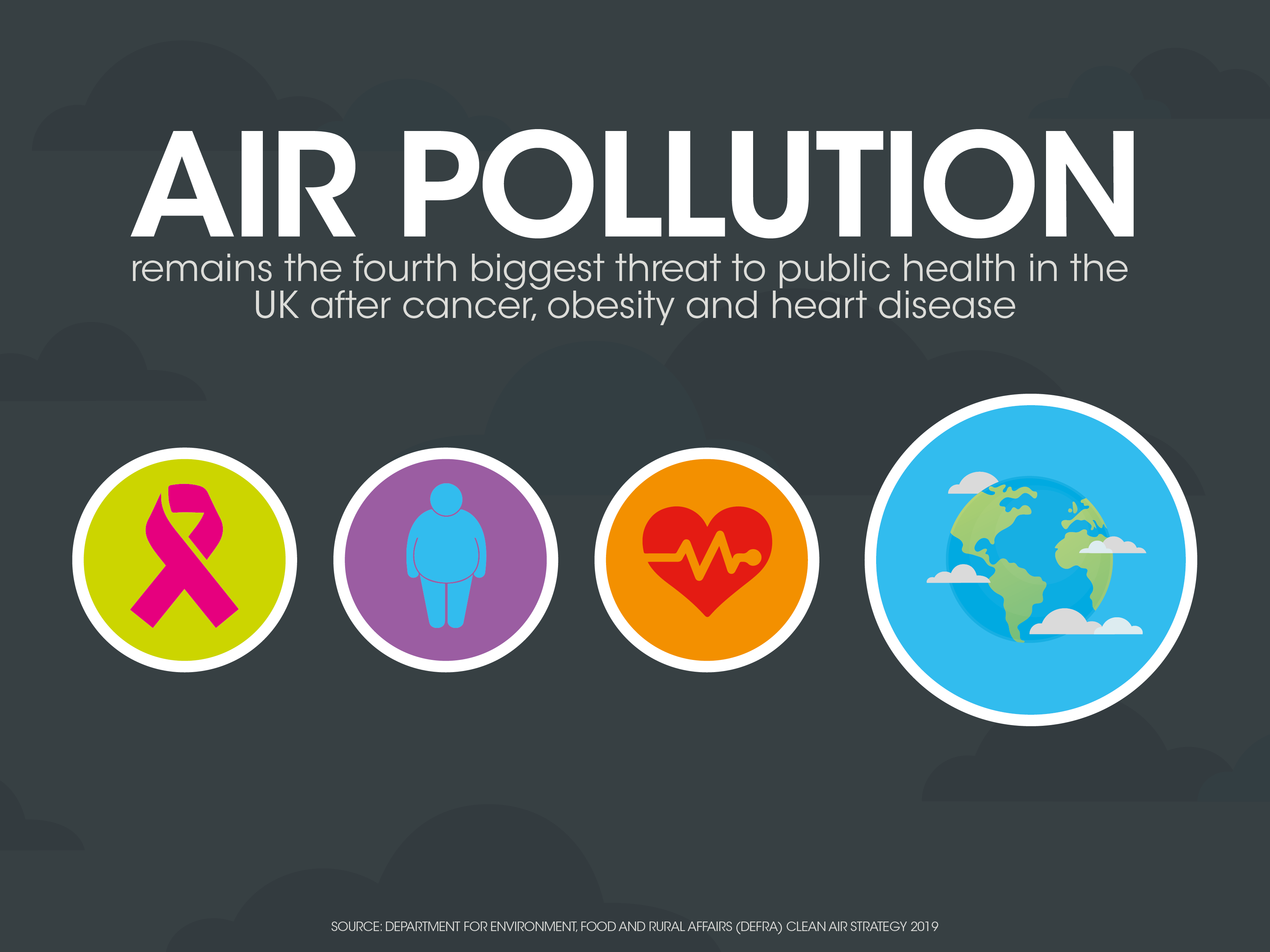Nitrogen oxides (NOx) are a group of gases that are predominantly formed during the combustion of fossil fuels. The majority of NOx emitted as a result of combustion is in the form of nitric oxide (NO). When NO reacts with other gases present in the air, it can form nitrogen dioxide (NO2 ), which is harmful to health. It is also important in the formation of ozone. NO coverts to NO2 very quickly and vice versa. It is therefore usual scientific practice to refer to the two gases together as NOx.
24th October 2019
UK Air Pollution and Transport – It’s Time to Clear the Air

Air pollution is the top environmental risk to human health in the UK, and the fourth greatest threat to public health after cancer, heart disease and obesity. It shortens lives and contributes to chronic illness.
Transport is a significant source of emissions of air pollution.
Towns and cities in the UK, and across the world, are currently struggling with high concentrations of nitrogen dioxide, a largely invisible pollutant stemming from road transport emissions, particularly older diesel vehicles and the UK Government’s Clean Air Strategy defines nitrogen dioxide as “the immediate air quality challenge”.
The Government is also looking for ways to reduce emissions from other sources such as brakes and tyres. Each time a car is driven, tiny pieces of particulate matter such as dust are released into the air from the brake wear, tyre wear and road surface wear.
These particles enter the airstream having a detrimental impact on human health for drivers, passengers and bystanders. Plastic particles from tyres are also deposited into our sewers and lead to harmful consequences to our marine wildlife and aquatic food chains.

Particulate matter, also called PM, is the term for tiny particles found in the air. It is formed in the atmosphere because of chemical reactions between pollutants. These particles include dust, dirt, soot, smoke, and liquid droplets.
Where does it come from?
Primary particles are released into the
atmosphere from a number of stationary
and mobile sources. The major mobile source
is road transport, which produces primary
particles when fuels are burned or lubricants
used up in the engine, tyres and brakes
wear down and from road dust.
What are the health effects
of particulate matter?
Particulate matter can negatively affect our health and contribute to illness.
In May 2018, the UK government was referred to the European Court of Justice (ECJ), as one of six European countries failing to meet legal limits on air quality and the High Court subsequently ruled that the UK had not put in place sufficient measures to reduce air pollution and protect public health.
Since the High Court decisions, the UK government has required over 60 local authorities to report on extra measures that they could take to reduce transport-related air pollution as quickly as possible. Measures being designed and funded include Clean Air Zones, transport infrastructure improvements, measures to encourage shifts to public transport, cycling or walking, and measures to encourage the uptake of cleaner vehicles (including electric vehicles).
Clean air zones are set up in areas where air pollution exceeds European legal limits, and councils are taking action to cut emissions. This ranges from improving traffic flow to charging the most polluting vehicles (mostly older diesels) a daily rate. Charging schemes are also known as low emission zones.
Government rules require income from the zones to be used for their operating costs or for other air quality measures. Clean air zones are starting to be set up across the country and won’t be affected by Brexit because the legislation is duplicated in British law.
The Government’s vision for Clean Air Zones is:
“Clean Air Zones improve the urban environment to support public health and the local economy, making cities more attractive places to live, work, do business and spend leisure time. They support cities to grow and transition to a low emission economy thus ensuring these benefits are sustainable for the long term.”
Over 60 local authorities are currently considering new clean air measures including the potential introduction of Clean Air Zones (CAZs). As a result almost every corner of the UK will be implementing some form of air improvement strategy within the next few years.
For more information view the BVRLA’s Interactive UK CAZ Map and our comprehensive guide to Clean Air Zones.
As you can see, plenty is going on across the country – and there will be plenty more detail to come as councils publish their plans.
With the rapid growth of Clean Air Zones across the UK, it is important for drivers to recognise the traffic signs which show they are entering/leaving a Clean Air Zone. Read our guide which clearly explains the symbols which will be used for both charging and non-charging Clean Air Zones across the UK.
The capital already had a non-charging low emission zone covering most of Greater London, but tighter emission standards were introduced for central London from 8 April 2019, under the new Ultra Low Emission Zone (ULEZ). This zone is now set to be expanded to cover most of Greater London from 25 October 2021.
Since the launch of the ULEZ in April, the number of non-compliant vehicles travelling through the capital daily has decreased by one-quarter.
Read our article to learn more about London’s Electric Vehicle Future.
By implementing designated Clean Air Zones in which polluting vehicles are fined to travel, UK cities could collectively reap economic benefits of £6.5bn.
This economic benefit comes from lower healthcare costs and fewer sick days taken by workers, in addition to funding raised through Clean Air Zone Charges.
What’s Next?
The UK Government has pledged to position the UK as the best place in the world to develop, manufacture and use zero exhaust emissions vehicles and, during the transition, to ensure that the cleanest conventional vehicles are driven on UK roads. All new cars in the UK will be “effectively zero emission” by 2040, under further plans to tackle air pollution.
However, the government is under pressure to bring forward this deadline and ban all sales of new petrol and diesel cars by 2032, after a report by a parliamentary committee described its plans as “vague and unambitious”.
Further into the future, zero emission zones will bring in much stricter limits with some mayors wanting petrol and diesel cars to be banned in their cities by 2030.